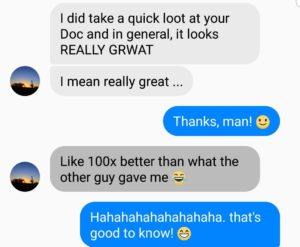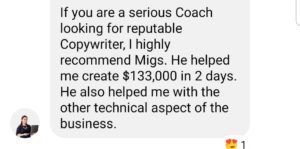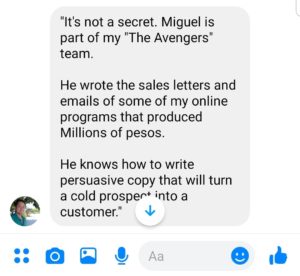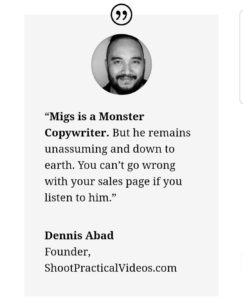Is your open rate less than 10% while unsubscribes are going to the roof?
If that’s the case, then your list isn’t as engaged as you want them to be.
There is a multitude of reasons why. Maybe your headlines aren’t good, your email content is boring, or you just don’t have the right audience.
If you have a problem with one (or all three), then read on. I’ll show you an autoresponder sequence I write for my clients. This sequence is proven to increase open rates and make you more trustworthy.
Now, there is a catch.
The first is this: the autoresponder sequence should be sent to subscribers who recently joined. If you’re just starting to build a list, then this is definitely for you.
Second, this is for people who genuinely want to build a relationship with their list. If you’re making a list just to make money off of them and not solve their problems, this might not be for you.
I’ll explain why by telling you what the first email is.

Contents
Email #1: Welcome Email
First impressions last, especially in email marketing. The first email is extremely important. It sets the tone of your relationship. Your subscribers will decide if they like you, hate you, or tolerate you on your first email.
Provide a good impression at the very start. Tell them you’re there to help. You’re only sending emails that can be beneficial to them. That’s how we write the welcome email.
Here is how the Welcome Email is structured:
Step #1: Introduce yourself
Make a brief introduction. Tell them who you are and what you do. If you have a brand name, tell them “welcome them to the [your blog’s name] family.”
Example: Hi, I’m Miguel Campaner. I just wanted to say Hi and welcome to my newsletter.
If you can add a picture or video in there of you saying hi, the better. Make it as personalized as you can and make it brief.
On the internet, it’s easy to pretend something you’re not. By sending an email like this, it slightly breaks that notion. You’re basically letting them know there is a REAL PERSON who sends them emails.
Step #2: Set Expectations
The next step is giving them something to look forward to. This portion is all about them. Tell them what they’ll receive, when they’ll get it, how it can benefit them, and the name that shows up when you send an email.
Example: I’m going to email you every MWF with blog posts and TTH with blog roundups.
If you see an email named “Miguel Campaner,” that’s me. Make sure to mark it as important to receive daily content about Making Money Online.
Including this bit is beneficial for you in three ways:
- they’ll expect your emails, so the chances of opens are higher
- If they mark it as important, all of your emails go straight to their inbox and not filtered to their “updates” or “promotions” or “spam” folders.
- It keeps you accountable. If you don’t do what you say, expect distrust and unsubscribes from your list.
Step #3: Send people to your Facebook Page, Twitter Page, and other Social Media Channels
Social media is essential in 2017. You can’t create an online business without it. After all, why wouldn’t you? You can network and have deeper connections with your audience through social media.
If you have social media channels, send your subscribers there. Or at least, tell them where you hang out and what you do on those platforms. They’ll feel closer to you, it will make you more “genuine” & “real,” and you’ll have the chance to meet and interact with them.
Again, the purpose of this email is to make them feel important. Put them first, provide value and success will follow.
A great example of a welcome email is from Danavir Sarria, founder of Copymonk:

Email #2: The “Problem/Empathy” Email
Email #2 won’t work if you don’t know the problems, pains, and frustrations of your target audience.
If you have a problem figuring out, send me a message here. I help clients get to know their target audience better.
The second email is where you call out your audience’s problems. Tell them point blank what it is. Elaborate it in further detail.
After that, show empathy. Let them know you understand their struggle.
If you can show them you know their problem better than they do, they’ll immediately see you as someone how can solve it.
The aim of this email is POSITIONING.
You position yourself as a problem-solver, as someone who can make their lives better or easier.
Here is how you do that:
Step #1: State problem
Capture your subscribers’ attention from the very first line. State the problem immediately or ask a question about the problem. For example…
- Are you struggling with [problem]?
- Does [problem] keep you up at night?
- Is [problem] your main concern right now?
- If you have a problem with [….], then check this out…
Your audience should be nodding “yes” while reading these lines.
Step #2: Agitate the problem
You agitate the problem through storytelling. Focus on the emotional aspect of having the problem – how painful, miserable, horrible, or awful it was.
Example:
- “I overheard some girls gossiping how fat I was. It was so humiliating.”
- “I can’t bend over because of my huge gut. Even tying my own shoelaces became a challenge.”
- “My friends kept telling me to get a 9-5 job because focusing on affiliate sites will just bury me deeper in debt.”
Don’t go overboard with this. It should still be realistic. That’s why sharing personal experiences are preferred.
Step #3: Give hope and solution
Tell your audience there’s light at the end of the tunnel. You know because you’ve experienced it first hand and you know how to overcome it.
Make a transition from chaos to hope and then hope to the solution.
Example:
- After years of trial and error, I finally created $2K stable income online. Now, I share all of my best knowledge here.
- I struggled until I stumbled upon a tool that made my life 3 times easier. You can get access to the tool, too, by clicking here.
- That’s when I met John Wick. I hired him and he solved all of my “pest” problems. He can solve yours too. Just click here to contact him.
Reminder: the purpose of Email #2 is to position yourself as a problem solver. Share your experience about the problem and how you found the solution.
Here is a great example from Stuart Walker, founder of NicheHacks.com:

You can share the solution on your email. Your solution can also be a helpful blog post, tool, or Email #3.
Email #3: The “Best Of” Email
Send your subscribers the best content you created in your niche. The content can be blog posts, podcasts, infographics, guest posts, and videos.
How can you pick which is the “best?” You’re obviously biased since you created them. See which is popular, shared the most, or ranks high on search engines.
Before you choose, each content should solve one specific problem your audience has. If it doesn’t, then don’t put it in this email.
The “Best Of” Email shows you’re an AUTHORITY in your niche. It reassures them you know what you’re doing, other people like your opinions, and most importantly, they believe your content is valuable.
This email has 3-parts:
(1) Introduction – say hi. Tell them what you’re sending them.
(2) The “Best of [Blog Name]” List – provide the best content you created and what specific problems they solve. If you have a page where you list all of your best blog posts, then great. Send them there.
(3) Sign off – say goodbye and ask them to share it if they found the content valuable.
Here is a great example from Pat Flynn, founder of Smart Passive Income:

Email #4: The “Origin” Email
Have you ever gone to a concert, musical, show or movie set and wanted the VIP or Behind-the-Scenes to pass? I did and your audience wants, too.
That’s basically what the “Origin” email is. It’s the VIP pass. You give them the Behind-the-Scenes access to your business. Share your story. Tell them how you got started, your thought process, your successes, failures, etc.
How did you become a success? Where are you right now and what do you want to accomplish?
Include anything you’re willing to share. But all of it should still be connected your positioning. Don’t excessively talk about your 4th-grade forearm fracture if you can’t tie it up on how you became a self-published author.
This email can be long or short. It doesn’t matter. Just make sure you connect with your audience.
At the end of the email, put a call-to-action. Ask them what they think or ask them to share their own experiences. Elicit a response. Gauge how well you connected with them by their responses.
Here is an excellent “Origin” email from Steve Chou, owner of MyWifeQuitHerJob.com:

Email #5, #6 & #7: The “Loop” Emails
The Loop Email is a long email cut into three. The first email is called the “open loop,” the second is “cliffhanger” and the last is the “closed loop.”
You start the Open Loop like any other email. However, at the end, you provide a cliffhanger.
The answer to the cliffhanger is in the second email. In the next email, again, you provide another cliffhanger that will be answered by the third email.
Since the third email is the last, you provide the solution they’ve been following. That’s why it’s called the “closed loop.”
These 3 emails should at least be one day apart.
To give you a better idea on how these works, here’s an example:
- Open Loop…
I have problem A. I struggled with it, but I found solutions to it called X, Y, and Z. Solution X solves A because …
In the next email, I will tell you how Solution Y solves problem A.
- Cliff Hanger…
In the previous email, we discussed how Solution X solves Problem A. Solution Y also solves problem A by….
Solution Z provides the easiest and most pain-free way to solve Problem A. In the next email, I will tell you why…
- Closed Loop…
Solution X & Y are great, but Solution Z is the best, quickest and most pain-free way because…
That’s how you execute a “Loop” email. You can have different loops open at the same time. However, I suggest not to do that if you’re a beginner. It will confuse you and it might disappoint your audience if you don’t deliver.
Here is a fantastic example from the Kissmetrics blog:

The Loop Email is great for many reasons. Your list is engaged and they will anticipate your emails.
WARNING: Make sure the “Closed Loop” email is worth the wait. Don’t provide general information. The information you share should be an “exclusive” only to your list.
In case you skimmed the entire post and landed here, the 7-day Email Sequence goes like this…
Welcome Email
Problem/Empathy Email
Best of Email
Origin Email
Open Loop Email
Cliffhanger Email
Closed Loop Email
Imagine sending your next email campaign. Instead of seeing 5, 6 or 15 percent open rates, you’re seeing 30%, 40%, maybe even 60% open rates.
Not only that, your subscribers are taking action. They like your content, they trust you and they start to become loyal fans.
Does that seem far-fetched? It’s not.
Do the work. Dig deep. You have everything you need to make it happen.







